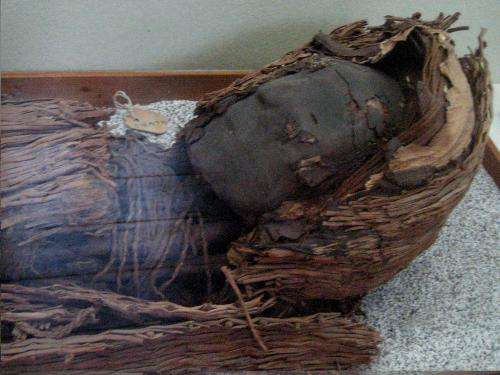August 14, 2012 report
Chilean team proposes theory on why early culture began to mummify their dead

(Phys.org) -- Researchers in Chile, led by Pablo Marqueta, an ecologist with Universidad Católica de Chile have come up with a new theory to explain why a civilization that thrived some seven thousand years ago suddenly began to mummify their dead. In their paper published in the Proceedings of the National Academy of Sciences, Marqueta and his team suggest that it was due to constant exposure to dead bodies as the group lived in an area that was so dry, bodies didn’t decompose.
Marqueta et al, hypothesized that the Chinchorro, hunter-gatherers that lived in the desert region of what is now northern Chile and southern Peru, from about 10,000 years ago to around 4,000 years ago, began mummifying their dead as a way to deal with the bodies of those that had passed on, but refused to decompose. The bodies wouldn’t decompose because it was simply too dry; the area is one of the driest places on Earth. Thus over time, because the Chinchorro buried their dead in shallow graves, the wind would partially uncover them, leaving those still alive to be constantly exposed to thousands of such bodies in their lifetime. But that was only part of the story they say.
After studying ice samples from a nearby volcano, and other ecological factors, the team deduced that the area in which the Chinchorro lived experienced a time around six to seven thousand years ago, of a relative increase in water, but not in the air. More snow fell in the mountains leading to more water flowing down into the valleys, which led to more fish in the ocean nearby. The Chinchorro thrived, leading to groups as large as a hundred or more individuals. And when group size increases, the team says, along with prosperity, culture thrives as new ideas are exchanged.
The combination of the two, the group says, led to burial rituals, one of which was mummification, a natural extension of what the people were already seeing around them. This idea is reinforced by the fact that when conditions changed the mummification stopped. Around four thousand years ago, the heavier snows in the mountains ceased, leading to less water, less fish in the ocean, and a declining human population.
More information: PNAS August 13, 2012 doi: 10.1073/pnas.1116724109
Journal information: Proceedings of the National Academy of Sciences
© 2012 Phys.Org



















